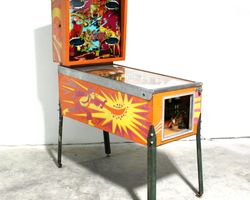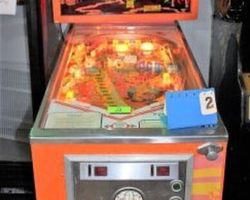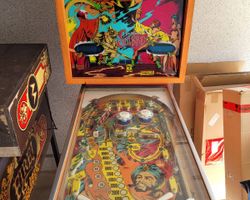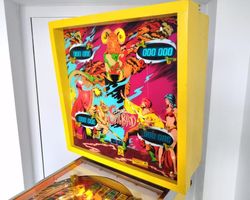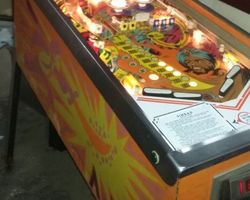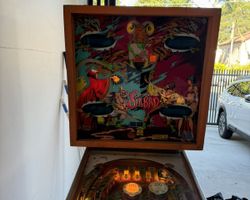Sinbad
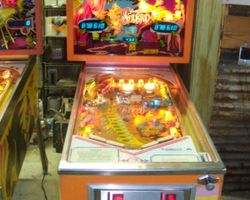
Average Prices: USD $300 to $1,200
Produced: Febuary, 1978
Production Run: 12,000 units
Machine Type: Solid State Electronic
MPU: Gottlieb System 1
Players: 4
Design by: Ed Krynski
Art by: Gordon Morison
D. Gottlieb & Company’s "Sinbad" pinball machine, released in February 1978, emerged at a pivotal moment in the industry’s transition from electro-mechanical (EM) to solid-state (SS) technology. With a production run of 12,000 units, split almost evenly between domestic and export markets, "Sinbad" quickly established its presence. Its inspiration drew from the classic Arabian Nights folk tales centered on Sinbad the Sailor, specifically tying into the 1977 Hollywood film "Sinbad and the Eye of the Tiger." This thematic choice allowed for vibrant, fantastical artwork and a narrative backdrop appealing to players.
The design of "Sinbad" was a collaborative effort, with Ed Krynski credited for the game design and Gordon Morison for the distinctive artwork. Krynski, a prolific designer for Gottlieb, brought his expertise to crafting a challenging and engaging playfield. Morison's artistic vision translated the mythical theme into a visually rich experience. The production process also saw experimental elements; some "Sinbad" units featured a lower cabinet constructed significantly from metal for the front, back, and bottom, with wooden sides and backbox. This unconventional cabinet material, while noted for being noisy and difficult to assemble, stemmed from internal discussions at Gottlieb, including input from Roman F. "Doc" Garbark, head of mechanical engineering. This particular design choice highlights Gottlieb’s willingness to innovate even in cabinet construction during this period. "Sinbad" was also notable as the first Gottlieb System 1 game to feature a unique apron art style, setting a visual precedent for subsequent machines. Interestingly, early sample games featured red plastic for start and flipper buttons, a detail that changed to green in later production models, alongside minor textual changes on the coin card holder. The machine stands as a prime example of Gottlieb's early solid-state endeavors, building upon the company's extensive experience with EM machines, even releasing 950 EM versions of a related design, and a two-player EM version titled "Eye Of The Tiger" alongside "Sinbad's" SS debut.
Distinctive Characteristics and Visual Appeal
"Sinbad" distinguishes itself with several unique elements that define its gameplay and aesthetic. Foremost among these is the distinct four-flipper setup: two flippers positioned on each side of the lower playfield. This configuration, while not unique to "Sinbad" in pinball history, is a central feature that significantly influences ball control and shot execution. Another prominent feature is the array of drop targets, which form the core of the game’s scoring strategy. These include two 3-bank drop targets and a single 4-bank drop target. The white and yellow targets are reset by one coil, while the purple targets respond to a separate coil, adding a nuanced layer to their interaction. A spinning target, depicting crossed swords, offers a dynamic element, visually reinforcing the machine's adventurous theme.
These features collectively enhance the gameplay experience. The four-flipper arrangement demands precision and adaptability from players, forcing a different approach to ball cradling and shot timing compared to standard two-flipper games. The multiple banks of drop targets provide clear objectives and satisfying tactile feedback when struck. The spinning target, while a more minor scoring element, adds visual flair and a momentary diversion on the playfield. The retention of chimes for sound, a characteristic carried over from Gottlieb's EM legacy, provides a classic auditory experience that many players find engaging, contrasting with the nascent and sometimes sparse digital sounds of early solid-state machines.
Playfield Dynamics and Architectural Flow
The "Sinbad" playfield presents a thoughtful layout designed by Ed Krynski to encourage strategic play and precise shots. The lower playfield is dominated by the four flippers, creating a narrower central channel for ball movement and requiring players to master the art of "scissoring" to control the ball between them. Above the flippers, several distinct areas draw the player’s attention. Two 3-bank drop targets are strategically placed on either side of the playfield, demanding accurate shots to clear them. A 4-bank drop target is situated further up, often requiring a more deliberate shot. Successfully clearing these drop target banks is paramount, as they are central to building the game's bonus multiplier.
Beyond the drop targets, the playfield features two pop bumpers that keep the ball in motion and provide chaotic rebounds, along with four star rollovers, crucial for lighting specific features and advancing bonus accumulation. A spinning target is positioned to offer a dynamic, high-scoring opportunity when hit repeatedly. Standup targets are also integrated into the layout, providing additional points and objectives. A notable aspect of the "Sinbad" playfield is the absence of traditional slingshots, a design choice that influences ball behavior and reduces unpredictable side-to-side ricochets, often leading to a more controlled, though equally challenging, game.
Gordon Morison's artwork on the playfield and backglass vividly brings the Sinbad theme to life. The backglass, in particular, is frequently praised for its detailed depiction of mythical creatures and the adventurous protagonist, rendered in a palette of blues, purples, and oranges that captivate the eye. The playfield artwork complements this, featuring intricate illustrations that guide the player's gaze towards key shots while maintaining thematic consistency. The lighting, typical of early solid-state machines, effectively highlights scoring opportunities and active features without overwhelming the visual design, contributing to an overall aesthetic that is both functional and captivating.
Engaging Gameplay and Strategic Depth
The gameplay dynamics of "Sinbad" are centered on a clear and compelling progression system. The primary objective revolves around systematically knocking down the various drop target banks. Each completed bank contributes to building a bonus multiplier, which is a significant source of points. The game rewards accuracy and patience, as players must carefully aim to clear these targets in sequence. The challenge is amplified by the four-flipper arrangement, which, while offering enhanced control to skilled players, can also lead to frustrating drains for the uninitiated, earning it a reputation for "scissoring" issues among some players.
Players often develop strategies around clearing the drop targets efficiently to maximize their bonus. Successful shots through the top rollovers can further light extra ball opportunities or special scores, adding another layer of strategic depth. While the spinning target offers a quick burst of points, the enduring focus remains on the drop targets and the accumulating bonus. The game's progression is straightforward to grasp, yet mastering the unique flipper control and the precise shots required for the drop targets provides a substantial and satisfying challenge. This simplicity in concept combined with depth in execution fosters an "one more game" addictive quality, drawing players back repeatedly to refine their technique and chase higher scores. The reliance on chimes for sound effects, rather than complex digital audio, gives "Sinbad" an auditory profile reminiscent of electro-mechanical games, contributing to its distinct charm and classic feel.
Enduring Acclaim and Lasting Influence
"Sinbad" has garnered a largely positive reception within the pinball community, consistently praised for its engaging and often addictive gameplay. Players frequently commend its replayability, noting a compelling desire for "just one more game." A central point of discussion, and often a source of both frustration and eventual appreciation, is the unique four-flipper setup. While some players initially find the dual flippers on each side challenging, leading to missed shots or unintended drains, many come to value the precise control and strategic possibilities they offer once mastered. The game's strong focus on drop targets, and the satisfying progression of building and collecting a large bonus multiplier, is a frequently cited strength. This core mechanic provides clear objectives and rewarding feedback.
The machine's aesthetics, particularly Gordon Morison's vibrant artwork on the backglass and playfield, are widely lauded, contributing significantly to its thematic immersion and visual appeal. The retention of chimes for sound, in an era of nascent and sometimes rudimentary digital audio, is often preferred, providing a classic auditory experience that enhances the game's charm. "Sinbad" is frequently recommended as an accessible classic for collectors due to its balanced value proposition and its skill-based gameplay, which rewards accuracy and patience, serving as an excellent training ground for ball control. Its overall pace can be fast, making for engaging, quick rounds, while still demanding deliberate, precise shots.
While predominantly praised, "Sinbad" does receive some feedback regarding its limitations. The four-flipper design, though appreciated by many, remains a common point of initial difficulty. The spinner target is occasionally noted as less impactful or desirable to shoot for compared to the central drop target game. As an early solid-state machine, its sound options are limited to chimes, lacking the varied sound effects or music found in later designs. Furthermore, the general reputation of Gottlieb System 1 electronics for requiring maintenance is sometimes mentioned, though the availability of modern replacement boards has largely mitigated this concern for collectors.
Despite minor criticisms, "Sinbad" holds a strong legacy within pinball history. It stands as a significant early solid-state offering from Gottlieb, bridging the gap between the mechanical past and the electronic future. Its design choices, particularly the emphasis on skill-based drop target play and the distinctive flipper layout, showcase Gottlieb's approach to game design during this transitional period. "Sinbad's" enduring appeal lies in its combination of a straightforward rule set with a challenging execution, establishing it as a memorable and rewarding experience for those who appreciate precise, strategic pinball play.
Sponsored Links
 Ebay Listings
Ebay Listings
 Auction Results
Auction Results
| Cost | Location | Date |
|---|---|---|
| USD $2,000 |  Washington, United States Washington, United States |
29 September, 2025 |
| AUD $855 |  Queensland, Australia Queensland, Australia |
04 September, 2024 |
| USD $1,500 |  Michigan, United States Michigan, United States |
14 August, 2024 |
| AUD $5,500 |  New South Wales, Australia New South Wales, Australia |
03 December, 2023 |
| USD $2,500 |  Colorado, United States Colorado, United States |
26 October, 2023 |
| EUR €757 |  Baden-Württemberg, Germany Baden-Württemberg, Germany |
24 June, 2023 |
| EUR €590 |  Niedersachsen, Germany Niedersachsen, Germany |
17 April, 2023 |
| USD $550 |  Pennsylvania, United States Pennsylvania, United States |
13 February, 2023 |
| USD $2,875 |  Texas, United States Texas, United States |
14 September, 2022 |
| USD $3,995 |  California, United States California, United States |
14 July, 2022 |


Private Policy · Search Website · Contact Us
As an eBay Partner, we may earn a commission from qualifying purchases made through links on this site, at no additional cost to you.
All trademarks and copyrighted materials remain property of their respective owners. All other content copyright 2007 - 2026 Pinpedia.

